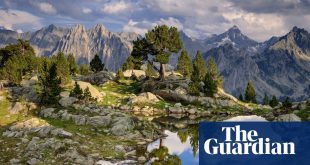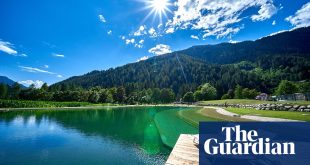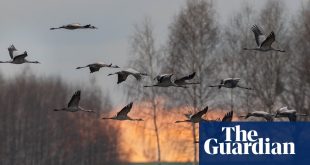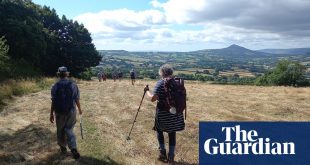“Watch!” Mick Oliver, my guide, takes a big jump on the scrubby ground. To my surprise, the earth ripples beneath our feet. “Did you see the heather vibrate? Just below us the peat is about 95% water,” he says. “We are literally walking on water.”
I’m at Hatfield Moors, 13 miles east of Doncaster in South Yorkshire, to explore rare habitat – the UK’s largest lowland raised mire. Oliver, a passionate, active octogenarian and former mining surveyor, is part of a management group responsible for the moors’ conservation. He’s sharing some of his profound knowledge of flora, fauna and mycelium – gained over 30 years of walking, working on, studying and, at times, fighting for this land – before I explore the 1,400 hectare (3,500-acre) wetland.
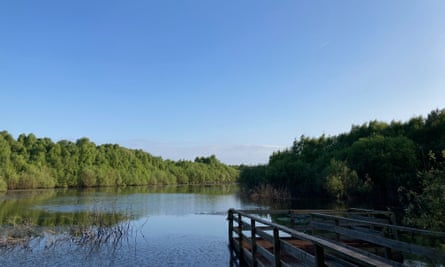
Hatfield Moors is a post-industrial landscape. Once extensively mined for peat, it was designated a site of special scientific interest in the 1990s and secured European protection as an area of important conservation. It is managed by Natural England and is home to stunning walks, rare wildlife and plants, an abandoned RAF base and a thriving Buddhist community. The flora varies from patches of young deciduous woodland and open scrub – thick with heather and ferns and dotted with pines – to lakes, ponds and swathes of wetland.
The moor was once a raised bog and part of the conservation work involves “rewetting”. Water levels are lifted through the building of weirs, underground runners and dams and the removal of trees. “Some of these plants have laid dormant in the desiccated peat for four decades but, since rewetting, they’re coming back,” said Oliver. The plants and fungi in question include common and hare’s tail cotton grass, bog rosemary, candlesnuff fungus and sphagnum mosses, which are largely responsible for forming peat once they’ve died.
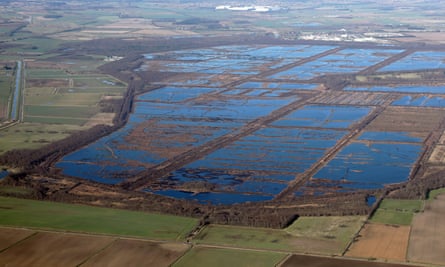
I set off to explore, starting at Boston Park, where there’s a choice of maps for short and extensive circular and linear walks along sign-posted routes. I follow a trail through woodlands and scrub and past pretty lakes and ponds populated by tufted ducks and kingfishers. Tantalising pathways lead off into the woodlands but I’m reminded of Oliver’s advice to stick to the trail – numerous signs warn about adders and it’s easy to get lost here.
After 40 minutes, I reach a viewing platform overlooking the vast Packard’s Heath, known for its breeding nightjars. Lapwing, heron, hobby and cuckoos fly overhead. Fifty yards away lies a mound built as tribute to four Polish airmen who lost their lives here during the second world war. Fragments of their aircraft are scattered on the mound along with a memorial.
The moors are flora- and fauna-rich in every season. In spring, the air is sweet with the songs of warblers, finches and cuckoos. During summer, the moor is resplendent with acres of colourful heather, itself home to myriad funnel spiders. Lucky visitors may even find the quiet punctured with the wild trumpeting call of cranes, breeding on the moors again after 400 years. In the evenings, nightjars can be heard churring; barn owls silently quarter the landscape. In breeding season – May to September – visitors are not permitted on some parts of the moors. It is not just for the nesting cranes and nightjars but the bugs too. The high volume of insect life is striking: the air is thick with dragonflies, beetles, mosquitos and flies. This is one of only three places in the world where mire pill beetles are known to breed. Being only a millimetre in length they’re far from easy to spot; for the enthusiastic naturalist, binoculars and magnifying glass are recommended.
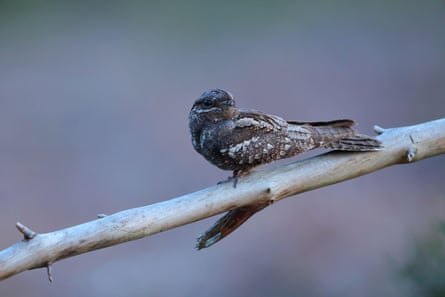
From the viewing tower, the panoramic landscape is stunning – more reminiscent of parts of Suffolk or Arne Nature Reserve on the Isle of Purbeck than South Yorkshire. More unusual still, it overlooks a reconstructed section of a 5,000-year-old Neolithic timber trackway and platform, laid out in metre-long sections of pine. An official plaque attributes the extraordinary discovery in 2004 to – who else? – Mick Oliver. The sign asserts that the trackway was just a hundred metres in length, and was presumed to be have been used for some kind of sacred ceremony (though Oliver believes it was once part of an extensive Neolithic pathway, a north-south migration root across the moorland).
I return again the next day to walk the long, straight pathway past shimmering waterways and carpets of cottongrass from Boston Park to Ten Acre car park then two miles beyond to Gomde, a Tibetan Buddhist centre and living community in the heart of this wetland. Formerly known as Lindholme Hall, the building was only accessible by boat until the area was drained and a road built.

Gomde and the Lindholme Estate offer cabin retreat in its woods and run a weekly meditation to which all are welcome (contacting them before visiting is essential). While their colourful temple space is housed in a converted barn, a more ambitious plan to build a traditional three-storey Buddhist temple has started with the foundations being laid.
Dusty from the walk, I remove my boots, drink tea and chat with a few residents before heading to the temple for the evening’s meditation. By the feet of a statue of Buddha lay seven bowls containing special offerings known as yonchap, particular to this Tibetan form of Buddhism. As I close my eyes, it occurs to me that in this beautiful landscape, where an endangered ecosystem is returning thanks to the dedicated work of Oliver and others, the special offerings in those seven bowls couldn’t be more appropriate: water.
For more information and to find directions, visit the Humberhead Peatlands National Nature Reserve website
 Top Naija News: Nigerian News, Breaking News Nigeria and World News Top Naija News is a daily news publication in Nigeria, delivering the latest breaking news in Nigeria and around the world.
Top Naija News: Nigerian News, Breaking News Nigeria and World News Top Naija News is a daily news publication in Nigeria, delivering the latest breaking news in Nigeria and around the world.
